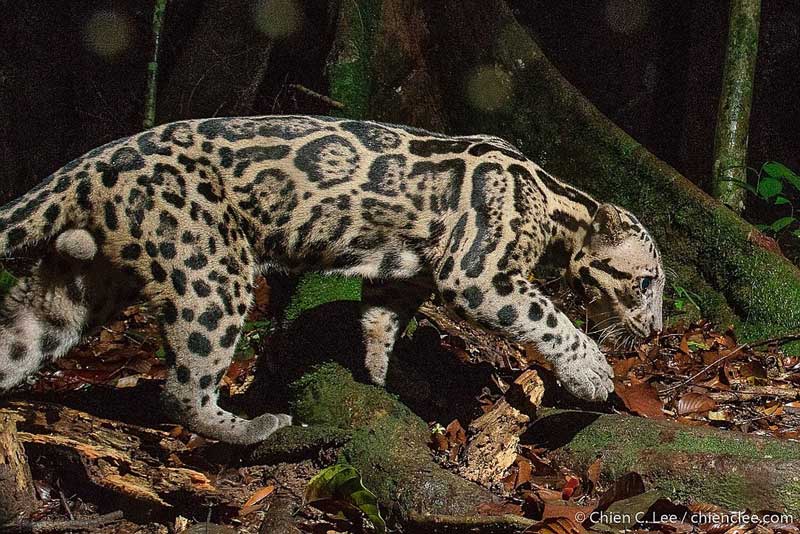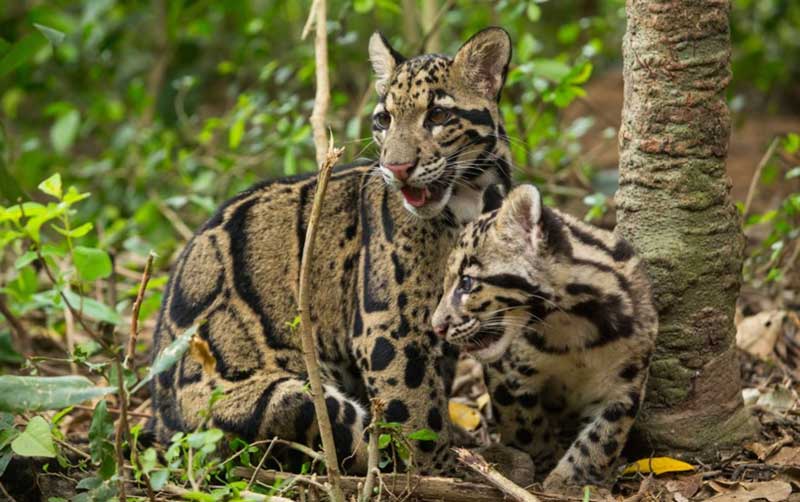
Isolated just on two islands in Southeast Asia, the little-known, forest-dependent Sunda Clouded Leopard is the newest and the smallest big cat species, known to science, with a head typical of a big cat, like the tiger, jaguar or snow leopard. Its name refers to the small irregular cloud-like patterns on its greyish yellow or grey fur, which are frequent spots inside and form two or more rows that are arranged vertically from the back on the flanks.
Also known as the Sundaland Clouded Leopard, Enkuli Clouded Leopard, Diard’s Clouded Leopard and Diard's Cat, it was classified as a different species in 2006, distinct from the Clouded Leopard in mainland Southeast Asia.

The Sunda clouded leopard occurs only on the islands of Borneo and Sumatra. In Borneo, it lives in the lowland rainforest and at a lower density in the logged forest below 4900 feet (1500 m), with strongholds in the Leuser, Kerinci Seblat and Bukit Barisan Selatan National Parks. It is also found in the Heart of Borneo Landscape that spans the three territories of Malaysian Borneo, Indonesian Borneo and Brunei Darussalam.
In Sumatra, it is apparently found in abundance in hilly, Montane areas, but it is unknown whether the Sunda clouded leopard still occurs on the Batu Islands near Sumatra. As fossils of clouded leopards have been found in Java, it is estimated that possibly it has been extinct from the island since the Holocene.

The stocky built Sunda Clouded Leopard weighs around 12 to 26 kg (26 to 57 lb) and has a very long tail with black spots and rings towards the tip, which can grow to be as long as its body. Its long tail and short legs help it to move easily in the trees. While the tails of the males are long and slender, females tend to have somewhat fluffy tails.
Its canines are 2 in (5.1 cm) long, which are relatively larger in proportion to the size of its skull and are longer than those of any other living cat. Its pupils contract to vertical slits and it can purr as its hyoid bone, located in the front of the neck, just below the lower jaw, carrying the weight of the tongue, is ossified.

Very little information about the habits and behaviour of the Sunda clouded leopard is available due to its secretive nature. However, it seemed to be generally solitary, hunts mainly on the ground mostly at night, but can also be active during the day. The Sunda clouded leopard is an excellent climber; it moves easily through the trees where it has been observed hunting primates and uses its climbing skills to hide from dangers. But it has been speculated that Sunda clouded leopards on Borneo are probably less arboreal than on Sumatra where tigers also occur. It has been suggested that they travel extensively on the ground along forest trails and logging roads. The home range of a male Sunda clouded leopard estimated by a camera trap study exceeded 45 square km, while a female in a selectively logged forest in Sabah in 109 days was 16.1 square km, with a core area of 5.4 square km.

Sunda clouded leopards are carnivores and they prey on a variety of arboreal and terrestrial species, depending on availability. They mainly prey different types of monkeys and gibbons, sambar deer and mouse deer, siamang and long-tailed macaques, pigs, porcupines and rodents. They may also hunt birds and occasionally take livestock such as goats and chickens.

Although the Sunda clouded leopards do not have any specific breeding season and they may breed year-round, the peak usually takes place from December through March. After a gestation period of around 90 days, the female gives birth to a litter of 1-5 closed-eyed and toothless cubs. The young are usually weaned and become independent from their mother at age of 10 months and by the age of 2 years, they become sexually mature.

The Sunda clouded leopards are strongly forest-dependent animals and their major threat is habitat loss due to deforestation. It has been estimated that in Sumatra and Borneo, approximately 30% of the Sunda clouded leopard's forest range has been lost over the past 10 years, mostly due to clearance for accommodation and agricultural purposes, especially for oil palm plantations. The picture is more grim in Sumatra, where already up to 80% of the prime rainforest has been felled. Another threat is poaching and illegal trade. Sunda clouded leopard skins and body parts have high commercial value in the Asian medicinal trade and between 2011 and 2019, body parts of 32 individuals were seized, apart from several live individuals, skins, canines and claws. In addition, the Sunda clouded leopards are also culturally important at a local level and their skins are found in ceremonial clothes in some regions. Although currently, it is fully protected in Indonesia, Malaysia and Brunei, it seems that successful conservation efforts require complete prevention of habitat destruction, prevention of poaching activities, increasing public awareness and strong implementation of the prohibitive laws.